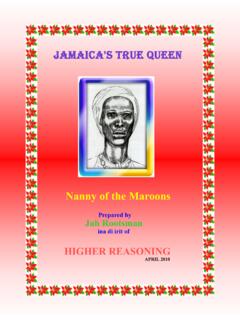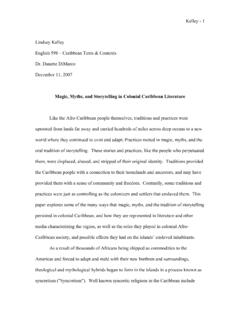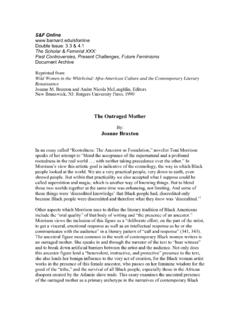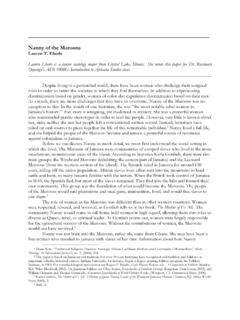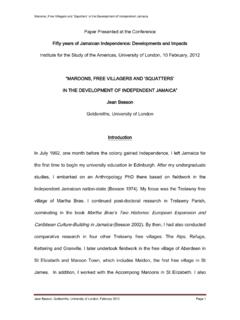Transcription of History of Portland - The National Library of Jamaica
1 History of Portland The Parish of Portland is located at the north eastern tip of Jamaica and is to the north of St. Thomas and to the east of St. Mary. Portland is approximately 814 square kilometres and apart from the beautiful scenery which Portland boasts, the parish also comprises mountains that are a huge fortress, rugged, steep, and densely forested. The Blue Mountain range, Jamaica highest mountain falls in this parish. What we know today as the parish of Portland is the amalgamation of the parishes of St.
2 George and a portion of St. Thomas. Portland has a very intriguing History . The original parish of Portland was created in 1723 by order of the then Governor, Duke of Portland , and also named in his honour. Port Antonio Port Antonio, the capital of Portland is considered a very old name and has been rendered numerous times. On an early map by the Spaniards, it is referred to as Pto de Anton, while a later one refers to Puerto de San Antonio. As early as 1582, the Abot Francisco, Marquis de Villa Lobos, mentions it in a letter to Phillip II.
3 It was, however, not until 1685 that the name, Port Antonio was mentioned. Earlier on Portland was not always as large as it is today. When the parish was formed in 1723, it did not include the Buff Bay area, which was then part of St. George. Long Bay or Manchioneal were also not included. For many years there were disagreements between St. Thomas in the East Port Antonio and town of Titchfield. ( Portland ) and Portland about where this area belonged until in 1779 Manchioneal was at last given to the Portland Vestry. Later on in 1867 when the Governor, Sir John Peter Grant cut down the number of parishes from twenty two to fourteen, Buff Bay and Long Bay were added to Portland .
4 Settlement In 1721, enormous efforts were made to induce immigrants from the British Isles to settle in the north eastern part of the island. It is said that when Portland came into existence, anyone who settled within twelve months was to be entitled to a barrel of flour and two barrels of beef on his/her arrival. This was to be handed over to him by a beneficent Government of Port Antonio free of cost; for three years. To encourage new settlers and on account of the distance from the Supreme court, all settlers were to be exempted from all suits, actions or arrest, that might take them to distant Spanish Town.
5 These attractions, however, proved ineffectual as it is noted that the inducements were offered to new immigrants only, and no one in Jamaica really believed the north east was safe on account of the Maroon settlement there. It is often said that under British rule, the Maroons were perhaps the first people to settle in Portland , and as a result, this along with unfavourable climate did not attract settlement. It was not until 1725 that the benefits of the laws were vainly extended to residents of the land. Another way in which the government tried to encourage settlement in Portland was empowering the Governor to make land grants in the King s name.
6 To every white person, being a protestant, thirty acres; to every white person in the family, thirty acres; to every free mullatoe Indian or Negro, twenty acres; to every slave bought, five acres; with a proviso that no person not having fifteen white persons in the family should have above four hundred acres in the whole. Another condition was that the grantees should settle and plant the land, or some part thereof, within six months from the date of the patent, and should not alienate the land for seven years from that date.
7 In addition to that, special facilities were given to intending settlers: the lands were cleared from all arrears of quit rent and all grants made without fee of office, and the settlers free from all taxes general or parochial except quit rents for seven years. In 1743 settlers in Portland were granted the same privileges as persons settling at Manchioneal and Norman s Valley in St. Thomas in the East. That is; their passages were paid and that of their slaves not exceeding twenty, and the receiver general was to subsist them and their slaves for twelve months on the following scale: each white person 4 barrels of beef and 400 lbs of biscuit or bread; each slave a barrel of Herrings and 400 lbs of biscuit or bread the number of slaves not exceeding 20.
8 It is said that under the inducements of the laws passed between 1736 and 1752, in 16 years, 108 families and 15 artificers (skilled craftsman) were introduced into Portland . In 1780, all the restrictions, conditions, penalties and forfeitures imposed on settlers by the several Acts from 1721 to 1776 having failed, were repealed. Subsequent to this, lands were to be held free from such restrictions and therefore, grants were to be made free with a proviso excepting persons who had within four years before evaded the conditions of their grants.
9 Maroons and Portland Originating from the Gold coast of Africa, Maroons were ex-slaves who ran away and took to the hills in an attempt to escape their captors, determined to keep their freedom. Much like St. Thomas, their presence in the parish of Portland was very strong. The eastern Maroons settled in the Blue Mountains in Portland and were joined by runaway slaves in St. Thomas and other parishes, thus forming the Windward Maroons. The Maroons of Portland greatly affected the settlement of the parish by white people. The Maroons raided various towns in Portland and its environs, and historians have noted that for 76 years, the Assembly spent nearly 250,000 trying to defeat the Maroons in Portland .
10 The Maroons were said to comprise not more than 600 women and children. Qua, who emerged as the leader of the eastern Maroons, was said to have a fighting force of only 300 men. In 1723, a group of volunteers captured the settlement of Moore Town, but this was retaken by the Maroons the following year. The Windward Maroons terrified a few inhabitants of Port Antonio when they captured three estates within three miles of Port Antonio; other estates were plundered and burnt and many people killed. In 1774, while the maroons were plundering Port Antonio, a group of volunteers led by Colonel Brooks, captured nanny Town, one of the most important Maroon settlements.

